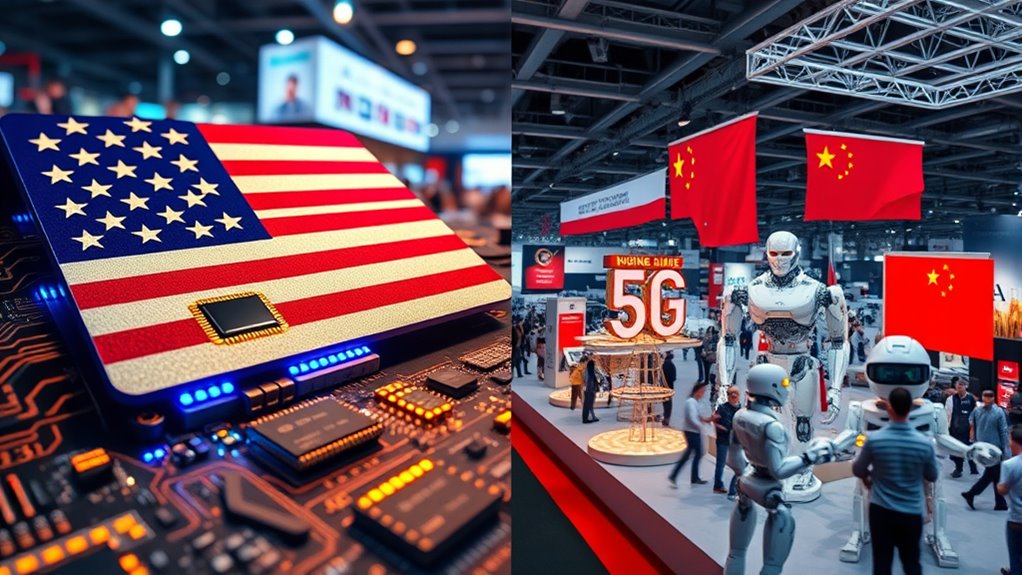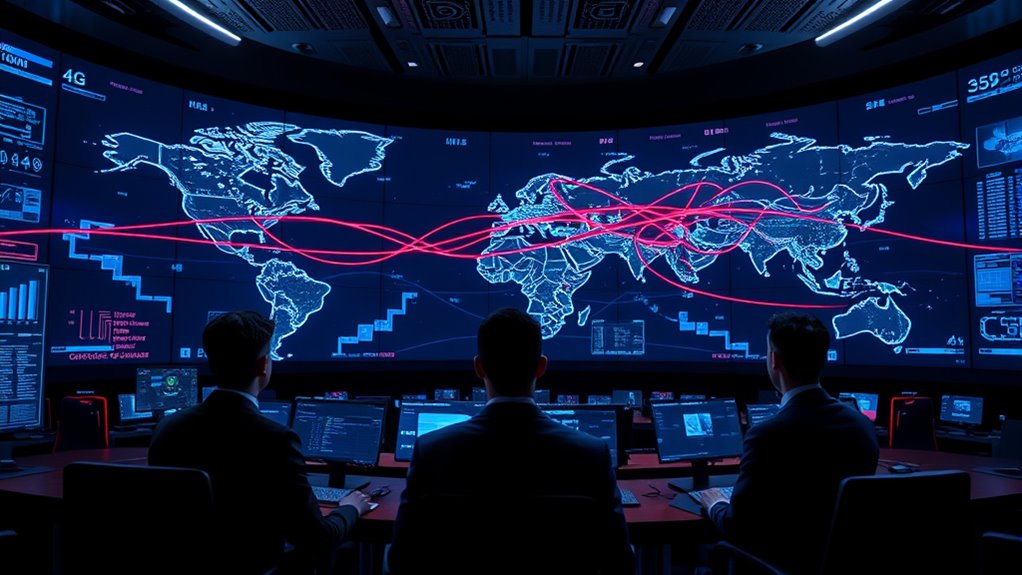The US–China tech war is all about fierce competition over chips, 5G, and AI. The US restricts China’s access to advanced semiconductors and equipment, while China invests heavily in domestic tech to become self-sufficient. Both countries race to lead in AI innovation, and the global rollout of 5G faces disruptions and fragmentation. As these tensions grow, you’ll uncover more about how this rivalry impacts your devices, costs, and the future of technology.
Key Takeaways
- The US–China tech war centers on competing for leadership in semiconductors, AI, and 5G technology, focusing on IP rights and innovation.
- US imposes export controls and bans on Chinese tech firms to protect advanced chip technology and prevent IP theft.
- China invests heavily in domestic research and supply chains to reduce reliance on foreign technology amid restrictions.
- Both nations race to develop advanced AI models and 5G networks, with geopolitical concerns affecting global rollout and cooperation.
- The conflict impacts global supply chains, causing device shortages, higher prices, and delays in accessing new technologies.

The US–China tech war has intensified as both nations compete for dominance in critical industries like semiconductors, artificial intelligence, and 5G technology. At the core of this battle is the fight over intellectual property, which is essential for maintaining technological edge. The US accuses China of IP theft and forced technology transfers, arguing that such practices undermine American innovation. In response, the US has implemented strict export controls and bans on Chinese tech firms, aiming to protect its intellectual property from being compromised or stolen. Meanwhile, China pushes to develop its own domestic tech industry, investing heavily in research and innovation to reduce reliance on foreign technology. This ongoing conflict over intellectual property rights shapes the broader dynamics of the tech war, influencing global supply chains and market access.
As these countries jostle for technological supremacy, the supply chain becomes a critical battleground. Semiconductors, often dubbed the brain of modern electronics, are especially crucial. The US has imposed restrictions on Chinese access to advanced chip manufacturing equipment, fearing that China could use these chips for military or surveillance purposes. Conversely, China is working to build a self-sufficient supply chain, investing in its own chip factories and seeking alternative sources of key materials. The disruption of global supply chains affects not only the tech giants but also consumers worldwide, leading to shortages of smartphones, computers, and other electronic devices. You might notice delays or higher prices as companies scramble to navigate these restrictions and secure the necessary components.
The competition extends beyond hardware to the software and services that run on these devices. In AI, both nations are racing to develop the most advanced models, with China focusing on government-led initiatives and the US leveraging private sector innovation. 5G technology is another front where supply chain resilience is essential; the US has pushed for alternatives to Chinese equipment, particularly from companies like Huawei, citing security concerns. This has led to a fragmented global 5G rollout, complicating the development of a truly interconnected network. As a consumer or business, you are impacted by these shifts—whether through increased costs, limited access, or the geopolitical tensions influencing the availability of new technologies. The importance of supply chain resilience becomes even more evident as disruptions ripple across the industry. Additionally, efforts to diversify supply sources and develop domestic manufacturing are key strategies in mitigating these risks. Recognizing the importance of technology self-sufficiency, many countries are investing in local research hubs and innovation centers to stay competitive. Strengthening intellectual property protections is also a major component in fostering innovation and safeguarding national interests.
Ultimately, the US–China tech war is reshaping the global technology landscape. Your access to the latest gadgets, software, and network services is directly affected by these strategic moves. Both nations aim to secure their technological future, but their actions also risk fragmenting the interconnected world of innovation. Keeping an eye on these developments helps you understand the bigger picture behind the devices you use every day and the geopolitical forces shaping the future of technology.
Frequently Asked Questions
How Will the Tech War Impact Global Supply Chains?
You’ll see supply chain disruptions as companies scramble to adapt to new restrictions and trade hurdles. This tech war prompts a manufacturing realignment, shifting production away from traditional hubs like China. Expect delays, increased costs, and a push for diversification. Countries and businesses will need to rethink sourcing strategies, making supply chains more resilient but also more complex, ultimately reshaping global trade dynamics for years to come.
What Are the Long-Term Economic Consequences for Both Countries?
You might find it surprising that, despite tensions, both nations could see a 0.5% dip in their economic growth over the next decade. Long-term, this tech war could stifle innovation prospects, slowing advancements in AI and 5G. China’s focus on domestic markets may boost self-reliance, while the US might lead in high-tech industries. Both countries risk reduced global influence and slower economic development if conflicts persist.
How Do International Organizations Influence the Tech Conflict?
You should know that international organizations influence the tech conflict through diplomatic pressure and regulatory influence. They can mediate disputes, set global standards, and push for fair practices, which impacts both countries’ strategies. By applying diplomatic pressure, organizations encourage cooperation or restraint. Their regulatory influence helps shape policies, ensuring tech development aligns with international norms, ultimately affecting how China and the US navigate their ongoing tech rivalry.
What Are the Cybersecurity Implications of the Us–China Tech Rivalry?
In this delicate dance of digital sovereignty, you should know the rivalry heightens cyber espionage risks, making your data more vulnerable. As both nations bolster defenses, you might face increased cyber threats, data breaches, or espionage attempts. This ongoing contest prompts you to stay vigilant and strengthen cybersecurity measures, understanding that the rivalry’s ripple effects influence the safety and integrity of your digital life in an evolving global landscape.
Can Diplomacy Resolve the Tensions in the Tech Sector?
Diplomatic negotiations and international cooperation could help ease tensions in the tech sector. You can push for open dialogue, fostering mutual understanding and trust between countries. By working together, nations can develop common standards, prevent escalation, and promote innovation. While challenges exist, active diplomacy offers a path to resolve disputes peacefully, ensuring that technological advancements benefit everyone and reduce the risk of conflict in this highly competitive landscape.
Conclusion
So, as you watch the US and China battle over chips, 5G, and AI, remember it’s less about innovation and more about a high-stakes game of tech turf wars. While they toss around trade restrictions and bans, the real losers are us—caught in the crossfire of their obsession with dominance. But hey, who needs reliable tech when you can have a front-row seat to the biggest, most expensive game of corporate chess ever played?








